1. How can we examine the environment of exoplanets?
> Thomas_frew
> Stage 2 Research Project: Exoplanetary Research
What the Hertzsprung-Russell Diagram Reveals about Stars. The stars are the most amazing physical engines in the universe.
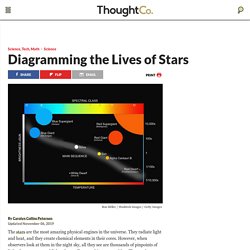
They radiate light and heat, and they create chemical elements in their cores. However, when observers look at them in the night sky, all they see are thousands of pinpoints of light. Some appear reddish, others yellow or white, or even blue. Those colors actually give clues to the temperatures and ages of the stars and where they are in their life-spans. Astronomers "sort" stars by their colors and temperatures, and the result is a famous graph called the Hertzsprung-Russell Diagram.
Exoplanet Atmosphere New Emission Transmission Spectra Analysis - Welcome. Exoplanet Athmosphere New Emission Transmission Spectra Analysis. CoRoT. A European space telescope that operated between 2006 - 2014 CoRoT (French: Convection, Rotation et Transits planétaires; English: Convection, Rotation and planetary Transits) was a space telescope mission which operated from 2006 to 2013.
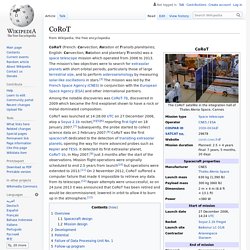
The mission's two objectives were to search for extrasolar planets with short orbital periods, particularly those of large terrestrial size, and to perform asteroseismology by measuring solar-like oscillations in stars.[3] The mission was led by the French Space Agency (CNES) in conjunction with the European Space Agency (ESA) and other international partners. Among the notable discoveries was CoRoT-7b, discovered in 2009 which became the first exoplanet shown to have a rock or metal-dominated composition. Overview[edit]
Kilodegree Extremely Little Telescope. The Kilodegree Extremely Little Telescope (or KELT) is an astronomical observation system formed by two robotic telescopes that are conducting a survey for transiting exoplanets around bright stars.
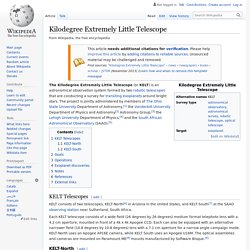
The project is jointly administered by members of The Ohio State University Department of Astronomy,[1] the Vanderbilt University Department of Physics and Astronomy[2] Astronomy Group,[3] the Lehigh University Department of Physics,[4] and the South African Astronomical Observatory (SAAO).[5] KELT Telescopes[edit]
NASA Frontier Development Labs (FDL) Project. Corot. Atmospheric composition of exoplanets based on the thermal escape of gases and implications for habitability. - NASA Chat: The Quest for Planets. Results Page. The target based query area provides filtering options to search the CHEOPS Archive on the basis of target related meta-data.
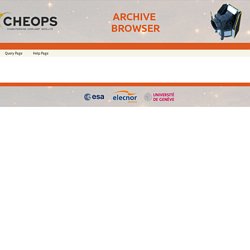
The filters available are the following: Target Name: Auto complete text box to filter by the name of the observed targets, that are currently stored at the CHEOPS Archive. The auto completion uses a case-insensitive search for the substring entered in the text box. All available matches are presented to the user, thus allowing an easy selection of the target name.Target Magnitude Min: Input text field to set a minimum range value to filter by the brightness of the target in V band.
CHEOPS KeyPerformances IOC June2020 v2.
CHEOPS Data - CHEOPS Guest Observers Programme - Cosmos. Observations made with CHEOPS are available for download from the CHEOPS mission archive which can be found at this link.
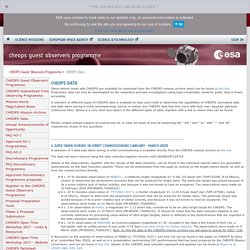
Proprietary data can only be downloaded by the respective principle investigators using login-credentials, however public data is freely accessible. A selection of different types of CHEOPS data is available to help users both to determine the capabilities of CHEOPS (simulated data and data taken during in-orbit commissioning) and to re-reduce any CHEOPS data that they have with their own, bespoke pipelines (reference files).
Below is a very brief description of the different types of data, together with a link to where they can be found.
(2) The Legacy of NASA's Kepler Space Telescope: More Planets Than Stars. Mission overview. Exoplanet Program: Missions. Kepler space telescope. Tenth mission of the Discovery program; optical space telescope for exoplanetology The Kepler space telescope is a retired space telescope launched by NASA to discover Earth-size planets orbiting other stars.[5][6] Named after astronomer Johannes Kepler,[7] the spacecraft was launched on March 7, 2009,[8] into an Earth-trailing heliocentric orbit.

The principal investigator was William J. Borucki.
SETI. As well as participating in the analysis of Breakthrough Listen data through SETI@home, we are inviting those who are interested to help us develop software and algorithms to process our data.
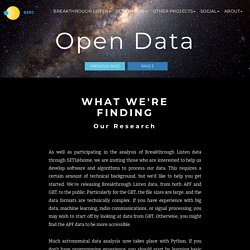
This requires a certain amount of technical background, but we’d like to help you get started. We’re releasing Breakthrough Listen data, from both APF and GBT, to the public. Particularly for the GBT, the file sizes are large, and the data formats are technically complex. If you have experience with big data, machine learning, radio communications, or signal processing, you may wish to start off by looking at data from GBT.
Mt. Hamilton Telescopes: Carnegie Double Astrograph. Lick Observatory's newest telescope, the APF, was fully commissioned on Mt.
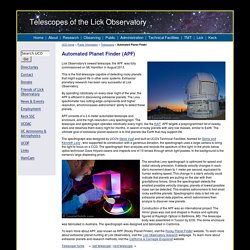
Hamilton in August 2013. This is the first telescope capable of detecting rocky planets that might support life in other solar systems. Extrasolar planetary research has been very successful at Lick Observatory.
Automated Planet Finder. A robotic optical telescope searching for extrasolar planets The Automated Planet Finder Telescope (APF) a.k.a.
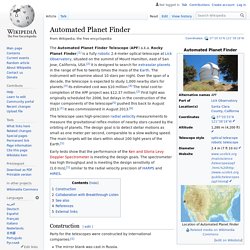
Rocky Planet Finder,[1] is a fully robotic 2.4-meter optical telescope at Lick Observatory, situated on the summit of Mount Hamilton, east of San Jose, California, USA.[2] It is designed to search for extrasolar planets in the range of five to twenty times the mass of the Earth. The instrument will examine about 10 stars per night.
Welcome to the AAPS. How our planet search works.
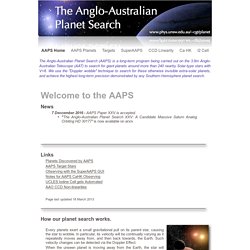
Planet Detection Papers I - First Results from the Anglo-Australian Planet Search: A Brown Dwarf Candidate and a 51 Peg-like Planet.Tinney et al. 2001, ApJ, 551, 507. ADS Abstract and Links II - Two New Planets from the Anglo-Australian Planet Search. Butler et al. 2001, ApJ, 555, 410.
Anglo-Australian Telescope. Until a few decades ago, ours was the only known solar system in the entire universe.
In fact, our solar system is just one of many, but finding other systems is incredibly difficult. The complexity arises from how bright stars are: they simply cause too much glare to be able to easily detect whether a smaller body such as a planet is orbiting it. Looking for a planet next to a star is like attempting to spot a pinhead next to a floodlight at a great distance. Looking for other solar systems comes down to searching for exoplanets (planets that are not part of our solar system).
The Anglo-Australian Planet Search. Anglo-Australian Planet Search. The Anglo Australian Planet Search or (AAPS) is a long-term astronomical survey started in 1998 and continuing to the present. It is being carried out on the 3.9-metre Anglo-Australian Telescope (AAT) of the Anglo-Australian Observatory in Australia. The purpose of this survey is to catalog planets around more than 240 nearby stars of the southern hemisphere.
List of exoplanet search projects.
From Wikipedia, the free encyclopedia Jump to navigationJump to search Wikipedia list article. Science & Technology - Exoplanet mission timeline. The first discoveries of exoplanets in the 1990s, by ground-based observatories, completely changed our perspective of the Solar System and opened up new areas of research that continues today. This infographic highlights the main space-based contributors to the field, including not only exoplanet-dedicated missions, but also exoplanet-sensitive missions, past, present and future. One of the first exoplanet-sensitive space telescopes was the CNES-led Convection, Rotation and planetary Transits mission, CoRoT, which launched in 2006.
PLATO (spacecraft)
European optical space observatory for exoplanet discoveries; medium-class mission in the ESA Science Programme Discover and characterize many nearby exoplanetary systems, with a precision in the determination of the planet radius up to 3%, of stellar age up to 10%, and of the planet mass up to 10% (the latter in combination with on-ground radial velocity measurements)Detect and characterize Earth-sized planets and super-Earths in the habitable zone around solar-type starsDiscover and characterize many exoplanetary systems to study their typical architectures, and dependencies on the properties of their host stars and the environmentMeasure stellar oscillations to study the internal structure of stars and how it evolves with ageIdentify good targets for spectroscopic measurements to investigate exoplanet atmospheres.
MINERVA-Australis. CHEOPS.










